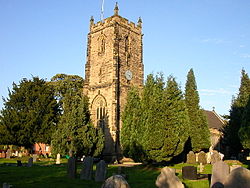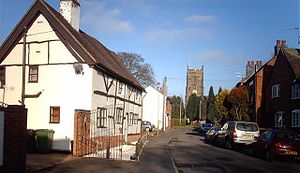Bulkington
| Bulkington | |
| Warwickshire | |
|---|---|
 St James' Church | |
| Location | |
| Grid reference: | SP3986 |
| Location: | 52°28’37"N, 1°25’30"W |
| Data | |
| Population: | 6,303 (2001) |
| Post town: | Bedworth |
| Postcode: | CV12 |
| Dialling code: | 024 |
| Local Government | |
| Council: | Nuneaton and Bedworth |
| Parliamentary constituency: |
Rugby |
Bulkington is a large village in Warwickshire, found about 6 miles northeast of Coventry, and just east of the towns of Nuneaton and Bedworth, and nearly engulfed by the townscape of the latter.
Today's Bulkington is largely a commuter village for larger nearby urban centres such as Coventry, Nuneaton, Bedworth, Hinckley and Leicester.
The village has connections with the locally born author George Eliot (Mary Ann Evans), who knew the village well. She referred to it as Raveloe in her book Silas Marner (1861). The church of St James is where George Eliot's uncle and aunt are buried.
Churches
- Church of England:St James' Church
- Congregationalist: Bulkington Congregational Church.
- Methodist: Ryton Methodist Church
- Roman Catholic: Our Lady of the Sacred Heart
Parish Church of St James
St James’ is the oldest church in Bulkington, dating to the 12th century. The church was given to the Abbey of Leister after its foundation in 1143. Following the Dissolution of the Monasteries the church came into the Crown’s hands until 1554, when it was passed on and sold numerous times before returning to the Crown’s possession by 1662. It has remained in the possession of the Crown since. Records for baptisms and burials begin in 1606 and for marriages in 1683.[1]
The church had chapels in Weston, Ryton, Marston, Bramcote, Shilton and Ansty; the latter two were transferred from the Abbey of Leicester to Coventry Priory, and subsequently became independent parishes.
The church today “consists of a chancel with a vestry on the north; a nave, with a clearstory to the south only; north and south aisles; south porch; and a western tower”. It displays a series of architectural developments from the 13th century through to the 20th, though the earliest material in the church dates from the 12th century, represented by a single voussoir and bell capital found in 1907 and built into the south porch. The tower was built in the mid 15th century and restored in 1907.[1]
The church has eight bells, the earliest of which belongs to the 16th century;[1] these can be heard on Sundays, and during the week when the bell ringers practice.
The Old Vicarage, a Victorian Tudor-Gothic building lies to the north-east of the church;[2] a modern, suburban style vicarage lies closer to the church.[3]
History
Bulkington is listed in the Domesday Book as Bochintone, thought to be from an Old English name Bulcan tun, meaning "Bulca's estate" after an otherwise unknown progenitor.[4]
The parish originally contained seven hamlets, two of which were subsumed by Bulkington village following residential building expansion which began in the 1930s.[5] These hamlets were Bulkington, Marston-Jabbet, Ryton, Weston in Arden, and Wolvershill, and parts of Barnacle and Bramcott.[6]
Ryton and Weston in Arden were subsumed by Bulkington village in the 20th century.|group="nb"}}
Historically the main industry in Bulkington was ribbon weaving.[1]
Middle Ages
The Domesday Book lists Bochintone as being among the estates of the Count of Meulan, overseen by his sub-tenant Salo. Originally the parish of Bulkington consisted of two 5-hide vills in the south Bulkington and Barnacle, and in the north Marston, Weston and Bramcote. The first four of these were held by the Count of Meulan.[1]
Bulkington was the largest of these sub-divisions (at 4 hides and 1 virgate) and functioned as the centre of the manor; however, by the late 13th century the centre of the manor had moved to Weston-in-Arden. By 1285 the manor of Weston contained Bulkington, Bramcote, Barnacle, Ryton, Clifton, and Wibtoft.[1]
The manor house Weston Hall, which dates to the 16th century, still stands in Weston-in Arden. It was substantially renovated in c.1892,[1] and after serving for a time as a night club in the 1970s and 1980s, now functions as a hotel.[7]
Early Modern period
Throughout the mediæval period and until the late 18th century, the principal employment in Bulkington had been agriculture:[8] 100 acres of meadowland were recorded in 1086; further, windmills are recorded for Weston and Marston Jabbet, and a water mill in Bramcote.[1] However, in 1766 700 acres of common land were enclosed at Ryton, and 4 years later enclosure was applied to the remainder of land in Bulkington, totalling 1,600 acres.[1]
Ribbon weaving supplemented or replaced agriculture as the main source of income for the majority of Bulkington’s population.[8] This cottage industry had spread to Bulkington from the major centres of Coventry and Bedworth,[8] where it had been introduced by the Huguenots in the 18th century.[9] The late 18th century and early 19th century was a period of significant growth for the village, with its population almost tripling in size.[8]
The 1830s saw a slump in the industry, due in part to the introduction of factory production at Coventry, and competition from cheap imports. However, the 1840s brought another period of growth when many buildings were re-fronted or rebuilt in chequered brick work (characteristic of North Warwickshire buildings of the period).[8]
The industry collapsed in the 1860s when customs duties on French silks were removed,[9] and this accompanied by a depression in agriculture led to a fall in the population by almost a third by 1891.[10] The Bulkington Baptismal register, 1841–1861, records that: 'On Thursday, Aug 15th, 1861, six families comprising 27 members left for Quebec, Canada, in consequence of the continued depression of the Ribbon trade… . At the same time 83 houses were vacant in the parish. Robert Potter, Vicar'.[11]
Nonetheless, ribbon production continued in Bulkington into the middle of the 20th century, though through small factory production rather than as a cottage industry. The last factory, in Arden Road, closed in the early 1950s.[10]
Twentieth century

Speculative private housing development began in the 1930s and by the 1960s surrounded the village with expansive suburban areas. In addition to the greenfield development of the 1960s, much of the village itself was redeveloped. This involved the creation of a shopping precinct in Leicester Street, which was the traditional heart of the village. Additionally, many of the chequered-pattern brick buildings were replaced by typical 1960s suburban houses.[12]
In 1968 a new east-west distributor road linking School Road and Bedworth Road replaced an ancient footpath. This development divorced the Church from Church Street; further road developments led to the demolition of a many of the buildings in the historic precinct, and by the 1980s only Church Street retained any historic continuity. The remaining historic buildings were threatened with demolition which led directly to the creation of the Bulkington Conservation Area in 1985, which covers Church Street and the area surrounding St James’ Parish Church. In November 2008 the Barbridge Close area, north of St James' Church, was excluded from the conservation area.[12]
Nos 3 and 4 Church Street, and the wrought iron railings on St James’ are also afforded listed status.[12]
Outside links
| ("Wikimedia Commons" has material about Bulkington) |
References
- ↑ 1.0 1.1 1.2 1.3 1.4 1.5 1.6 1.7 1.8 Salzman, L. F. (ed) (1951) 'Parishes: Bulkington', A History of the County of Warwick: Volume 6: Knightlow hundred, pp. 48-57 [1]
- ↑ Bulkington Conservation Area Appraisal & Management Proposals November 2008 (2008) p.13,17 Bulkington Conservation Area
- ↑ Bulkington Conservation Area Appraisal & Management Proposals November 2008 (2008) p.10,17 Bulkington Conservation Area
- ↑ Mills, A. D. (2004) "A Dictionary of British Place-Names", Oxford: OUP
- ↑ Bulkington Conservation Area Appraisal & Management Proposals November 2008 (2008) pp. 4,9 Bulkington Conservation Area
- ↑ 'Bulbridge - Bundley', A Topographical Dictionary of England (1848)
- ↑ Old Bulkington Website: Weston Hall
- ↑ 8.0 8.1 8.2 8.3 8.4 Bulkington Conservation Area Appraisal & Management Proposals November 2008 (2008) p.7 Bulkington Conservation Area
- ↑ 9.0 9.1 Bedworth Society Webpage: About Bedworth
- ↑ 10.0 10.1 Bulkington Conservation Area Appraisal & Management Proposals November 2008 (2008) p.8 Bulkington Conservation Area
- ↑ The Birmingham and Midland Society for Genealogy and Heraldry
- ↑ 12.0 12.1 12.2 Bulkington Conservation Area Appraisal & Management Proposals November 2008 (2008) p.9 Bulkington Conservation Area
- Allen, G. (2000) Warwickshire Towns & Villages, Sigma Leisure ISBN 1-85058-642-X
- 'Wyman, P. (1981) Bulkington Through the Ages
